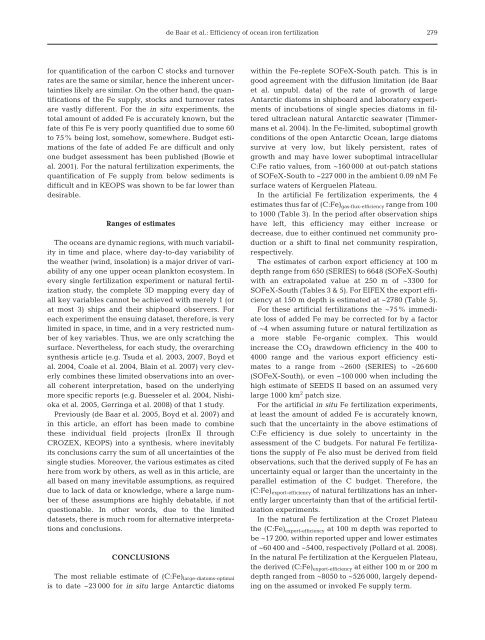Efficiency of carbon removal per added iron in ocean iron fertilization
Efficiency of carbon removal per added iron in ocean iron fertilization
Efficiency of carbon removal per added iron in ocean iron fertilization
Create successful ePaper yourself
Turn your PDF publications into a flip-book with our unique Google optimized e-Paper software.
de Baar et al.: <strong>Efficiency</strong> <strong>of</strong> <strong>ocean</strong> <strong>iron</strong> <strong>fertilization</strong>279for quantification <strong>of</strong> the <strong>carbon</strong> C stocks and turnoverrates are the same or similar, hence the <strong>in</strong>herent uncerta<strong>in</strong>tieslikely are similar. On the other hand, the quantifications<strong>of</strong> the Fe supply, stocks and turnover ratesare vastly different. For the <strong>in</strong> situ ex<strong>per</strong>iments, thetotal amount <strong>of</strong> <strong>added</strong> Fe is accurately known, but thefate <strong>of</strong> this Fe is very poorly quantified due to some 60to 75% be<strong>in</strong>g lost, somehow, somewhere. Budget estimations<strong>of</strong> the fate <strong>of</strong> <strong>added</strong> Fe are difficult and onlyone budget assessment has been published (Bowie etal. 2001). For the natural <strong>fertilization</strong> ex<strong>per</strong>iments, thequantification <strong>of</strong> Fe supply from below sediments isdifficult and <strong>in</strong> KEOPS was shown to be far lower thandesirable.Ranges <strong>of</strong> estimatesThe <strong>ocean</strong>s are dynamic regions, with much variability<strong>in</strong> time and place, where day-to-day variability <strong>of</strong>the weather (w<strong>in</strong>d, <strong>in</strong>solation) is a major driver <strong>of</strong> variability<strong>of</strong> any one up<strong>per</strong> <strong>ocean</strong> plankton ecosystem. Inevery s<strong>in</strong>gle <strong>fertilization</strong> ex<strong>per</strong>iment or natural <strong>fertilization</strong>study, the complete 3D mapp<strong>in</strong>g every day <strong>of</strong>all key variables cannot be achieved with merely 1 (orat most 3) ships and their shipboard observers. Foreach ex<strong>per</strong>iment the ensu<strong>in</strong>g dataset, therefore, is verylimited <strong>in</strong> space, <strong>in</strong> time, and <strong>in</strong> a very restricted number<strong>of</strong> key variables. Thus, we are only scratch<strong>in</strong>g thesurface. Nevertheless, for each study, the overarch<strong>in</strong>gsynthesis article (e.g. Tsuda et al. 2003, 2007, Boyd etal. 2004, Coale et al. 2004, Bla<strong>in</strong> et al. 2007) very cleverlycomb<strong>in</strong>es these limited observations <strong>in</strong>to an overallcoherent <strong>in</strong>terpretation, based on the underly<strong>in</strong>gmore specific reports (e.g. Buesseler et al. 2004, Nishiokaet al. 2005, Gerr<strong>in</strong>ga et al. 2008) <strong>of</strong> that 1 study.Previously (de Baar et al. 2005, Boyd et al. 2007) and<strong>in</strong> this article, an effort has been made to comb<strong>in</strong>ethese <strong>in</strong>dividual field projects (IronEx II throughCROZEX, KEOPS) <strong>in</strong>to a synthesis, where <strong>in</strong>evitablyits conclusions carry the sum <strong>of</strong> all uncerta<strong>in</strong>ties <strong>of</strong> thes<strong>in</strong>gle studies. Moreover, the various estimates as citedhere from work by others, as well as <strong>in</strong> this article, areall based on many <strong>in</strong>evitable assumptions, as requireddue to lack <strong>of</strong> data or knowledge, where a large number<strong>of</strong> these assumptions are highly debatable, if notquestionable. In other words, due to the limiteddatasets, there is much room for alternative <strong>in</strong>terpretationsand conclusions.CONCLUSIONSThe most reliable estimate <strong>of</strong> (C:Fe) large-diatoms-optimalis to date ~23 000 for <strong>in</strong> situ large Antarctic diatomswith<strong>in</strong> the Fe-replete SOFeX-South patch. This is <strong>in</strong>good agreement with the diffusion limitation (de Baaret al. unpubl. data) <strong>of</strong> the rate <strong>of</strong> growth <strong>of</strong> largeAntarctic diatoms <strong>in</strong> shipboard and laboratory ex<strong>per</strong>iments<strong>of</strong> <strong>in</strong>cubations <strong>of</strong> s<strong>in</strong>gle species diatoms <strong>in</strong> filteredultraclean natural Antarctic seawater (Timmermanset al. 2004). In the Fe-limited, suboptimal growthconditions <strong>of</strong> the open Antarctic Ocean, large diatomssurvive at very low, but likely <strong>per</strong>sistent, rates <strong>of</strong>growth and may have lower suboptimal <strong>in</strong>tracellularC:Fe ratio values, from ~160 000 at out-patch stations<strong>of</strong> SOFeX-South to ~227 000 <strong>in</strong> the ambient 0.09 nM Fesurface waters <strong>of</strong> Kerguelen Plateau.In the artificial Fe <strong>fertilization</strong> ex<strong>per</strong>iments, the 4estimates thus far <strong>of</strong> (C:Fe) gas-flux-efficiency range from 100to 1000 (Table 3). In the <strong>per</strong>iod after observation shipshave left, this efficiency may either <strong>in</strong>crease ordecrease, due to either cont<strong>in</strong>ued net community productionor a shift to f<strong>in</strong>al net community respiration,respectively.The estimates <strong>of</strong> <strong>carbon</strong> export efficiency at 100 mdepth range from 650 (SERIES) to 6648 (SOFeX-South)with an extrapolated value at 250 m <strong>of</strong> ~3300 forSOFeX-South (Tables 3 & 5). For EIFEX the export efficiencyat 150 m depth is estimated at ~2780 (Table 5).For these artificial <strong>fertilization</strong>s the ~75% immediateloss <strong>of</strong> <strong>added</strong> Fe may be corrected for by a factor<strong>of</strong> ~4 when assum<strong>in</strong>g future or natural <strong>fertilization</strong> asa more stable Fe-organic complex. This would<strong>in</strong>crease the CO 2 drawdown efficiency <strong>in</strong> the 400 to4000 range and the various export efficiency estimatesto a range from ~2600 (SERIES) to ~26 600(SOFeX-South), or even ~100 000 when <strong>in</strong>clud<strong>in</strong>g thehigh estimate <strong>of</strong> SEEDS II based on an assumed verylarge 1000 km 2 patch size.For the artificial <strong>in</strong> situ Fe <strong>fertilization</strong> ex<strong>per</strong>iments,at least the amount <strong>of</strong> <strong>added</strong> Fe is accurately known,such that the uncerta<strong>in</strong>ty <strong>in</strong> the above estimations <strong>of</strong>C:Fe efficiency is due solely to uncerta<strong>in</strong>ty <strong>in</strong> theassessment <strong>of</strong> the C budgets. For natural Fe <strong>fertilization</strong>sthe supply <strong>of</strong> Fe also must be derived from fieldobservations, such that the derived supply <strong>of</strong> Fe has anuncerta<strong>in</strong>ty equal or larger than the uncerta<strong>in</strong>ty <strong>in</strong> theparallel estimation <strong>of</strong> the C budget. Therefore, the(C:Fe) export-efficiency <strong>of</strong> natural <strong>fertilization</strong>s has an <strong>in</strong>herentlylarger uncerta<strong>in</strong>ty than that <strong>of</strong> the artificial <strong>fertilization</strong>ex<strong>per</strong>iments.In the natural Fe <strong>fertilization</strong> at the Crozet Plateauthe (C:Fe) export-efficiency at 100 m depth was reported tobe ~17 200, with<strong>in</strong> reported up<strong>per</strong> and lower estimates<strong>of</strong> ~60 400 and ~5400, respectively (Pollard et al. 2008).In the natural Fe <strong>fertilization</strong> at the Kerguelen Plateau,the derived (C:Fe) export-efficiency at either 100 m or 200 mdepth ranged from ~8050 to ~526 000, largely depend<strong>in</strong>gon the assumed or <strong>in</strong>voked Fe supply term.
















